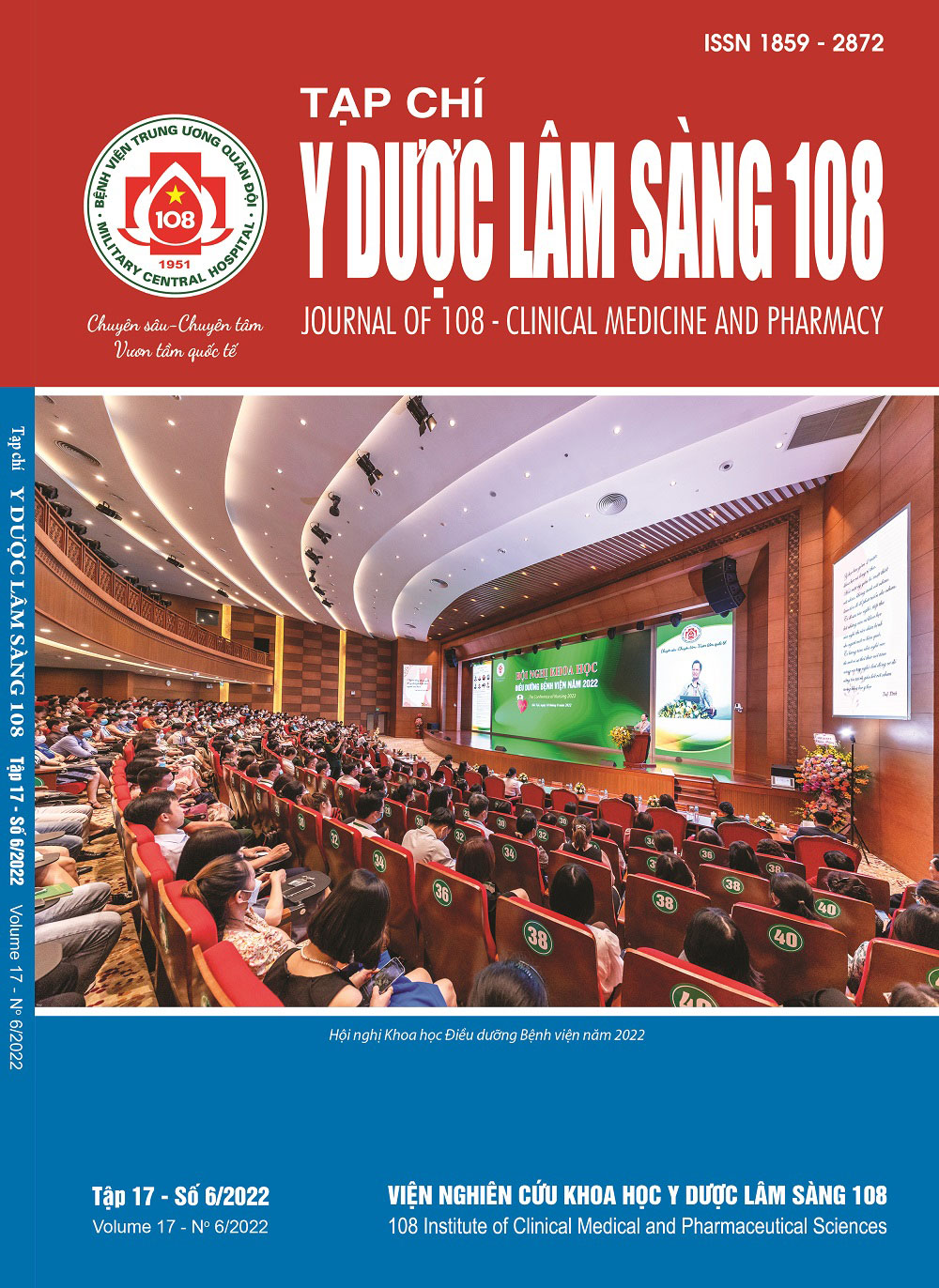Đặc điểm hình ảnh và giá trị của cắt lớp vi tính trong chẩn đoán hạch cổ di căn ở bệnh nhân ung thư tuyến giáp thể biệt hóa sau phẫu thuật cắt toàn bộ tuyến giáp
Main Article Content
Keywords
Tóm tắt
Mục tiêu: Mô tả đặc điểm hạch di căn vùng cổ và đánh giá giá trị của cắt lớp vi tính trong chẩn đoán hạch di căn vùng cổ ở bệnh nhân ung thư tuyến giáp thể biệt hóa sau cắt toàn bộ tuyến giáp và điều trị I-131. Đối tượng và phương pháp: Trong thời gian từ tháng 9 năm 2019 đến tháng 2 năm 2022, chúng tôi nghiên cứu tiến cứu 280 bênh nhân ung thư tuyến giáp thể biệt hóa đã được cắt toàn bộ tuyến giáp và điều trị ¹³¹I bằng phương pháp chụp CT có tiêm thuốc cản quang, phát hiện có 556 hạch vùng cổ. Kết quả: Trong tổng số 556 hạch, có 374 (67,3%) hạch di căn và 182 (32,7%) hạch lành tính. Vị trí hạch di căn thuộc nhóm VI chiếm tỷ lệ cao nhất 40,4% và nhóm V thấp nhất 3,5%. Trong số hạch di căn có 74,1% hạch ngấm thuốc mạnh, 16,0% có dấu hiệu nang hóa và 17,6% có vôi hóa. Dấu hiệu ngấm thuốc mạnh có độ nhạy 74,1%, độ đặc hiệu 82,4%, dấu hiệu nang hóa độ nhạy 16,0%, độ đặc hiệu 97,3%, dấu hiệu vôi hóa có độ nhạy 17,6%, độ đặc hiệu 96,7%. Tổng hợp các dấu hiệu của cắt lớp vi tính chẩn đoán hạch di căn vùng cổ có độ nhạy 79,4%, độ đặc hiệu 77,5%, độ chính xác 78,8%. Kết luận: Cắt lớp vi tính có tiêm thuốc cản quang cũng là một phương pháp có giá trị chẩn đoán hạch cổ di căn ở bệnh nhân ung thư tuyến giáp thể biệt hóa sau mổ cắt toàn bộ tuyến giáp.
Article Details
Các tài liệu tham khảo
2. Ha EJ, Chung SR, Na DG, Ahn HS, Chung J, Lee JY, Park JS, Yoo RE, Baek JH, Baek SM, Cho SW, Choi YJ, Hahn SY, Jung SL, Kim JH, Kim SK, Kim SJ, Lee CY, Lee HK, Lee JH, Lee YH, Lim HK, Shin JH, Sim JS, Sung JY, Yoon JH, Choi M (2021) 2021 Korean Thyroid Imaging Reporting and Data System and Imaging-Based Management of Thyroid Nodules: Korean Society of Thyroid Radiology Consensus Statement and Recommendations. Korean J Radiol 22(12): 2094-2123. doi: 10.3348/kjr.2021.0713.
3. Sakorafas GH, Koureas A, Mpampali I, Balalis D, Nasikas D, Ganztzoulas S (2019) Patterns of lymph node metastasis in differentiated thyroid cancer; Clinical implications with particular emphasis on the emerging role of compartment-oriented lymph node dissection. Oncol Res Treat 42: 143-147. doi: 10.1159/000488905.
4. Hoang JK, Vanka J, Ludwig BJ, Glastonbury CM (2013) Evaluation of cervical lymph nodes in head and neck cancer with CT and MRI: Tips, traps, and a systematic approach. AJR 200: 17-25. doi: 10.2214/AJR.12.8960.
5. Eun NL, Son EJ, Kim JA, Gweon HM, Kang JH, Youk JH (2018) Comparison of the diagnostic performances of ultrasonography, CT and fine needle aspiration cytology for the prediction of lymph node metastasis in patients with lymph node dissection of papillary thyroid carcinoma: A retrospective cohort study. International Journal of Surgery 51: 145-150. doi: 10.1016/j.ijsu.2017.12.036.
6. Wei Q, Wu D, Luo H, Wang X, Zhang R, Liu Y (2018) Features of lymph node metastasis of papillary thyroid carcinoma in ultrasonography and CT and the significance of their combination in the diagnosis and prognosis of lymph node metastasis. JBUON 23(4): 1041-1048.
7. Park JE, Lee JE, Ryu KH, Chung MS, Kim HW et al (2017) Improved diagnostic accuracy using arterial phase ct for lateral cervical lymph node metastasis from papillary thyroid cancer. AJNR Am J Neuroradiol 38: 782-788.
8. Cho SJ, Suh CH, Baek JH, Chung SR, Choi YJ, Lee JH (2019) Diagnostic performance of CT in detection of metastatic cervical lymph nodes in patients with thyroid cancer: systematic review and meta-analysis. European Radiology 29: 4635-4647.
9. Yang SY, Shin JH, Hahn SY, Lim Y, Hwang SY, Kim TH, Kim JS (2020) Comparison of ultrasonography and CT for preoperative nodal assessment of patients with papillary thyroid cancer: diagnostic performance according to primary tumor size. Acta Radiologica 61(1): 21-27.
10. Suh CH, Baek JH, Choi YJ, and Lee JH (2017) Performance of CT in the Preoperative Diagnosis of Cervical Lymph Node Metastasis in Patients with Papillary Thyroid Cancer: A Systematic Review and Meta-Analysis X C.H. Suh, X J.H. Baek, X Y.J. Choi, and X J.H. Lee. AJNR Am J Neuroradiol 38:154-161
11. Sun J, Li B, Li CJ, Li Y, Su F, Gao QH, Wu FL, Yu T, Wu L, Li LJ (2015) Computed tomography versus magnetic resonance imaging for diagnosing cervical lymph node metastasis of head and neck cancer: A systematic review and meta-analysis. OncoTargets and Therapy 8: 1291-1313.
12. Seo YL, Yoon DY, Baek S, Ku YJ, Rho YS, Chung EJ, Koh SH (2012) Detection of neck recurrence in patients with differentiated thyroid cancer: comparison of ultrasound, contrast-enhanced CT and 18F-FDG PET/CT using surgical pathology as a reference standard: (ultrasound vs. CT vs. 18F-FDG PET/CT in recurrent thyroid cancer). Eur Radiol 22: 2246-2254. doi: 10.1007/s00330-012-2470-x.
 ISSN: 1859 - 2872
ISSN: 1859 - 2872
